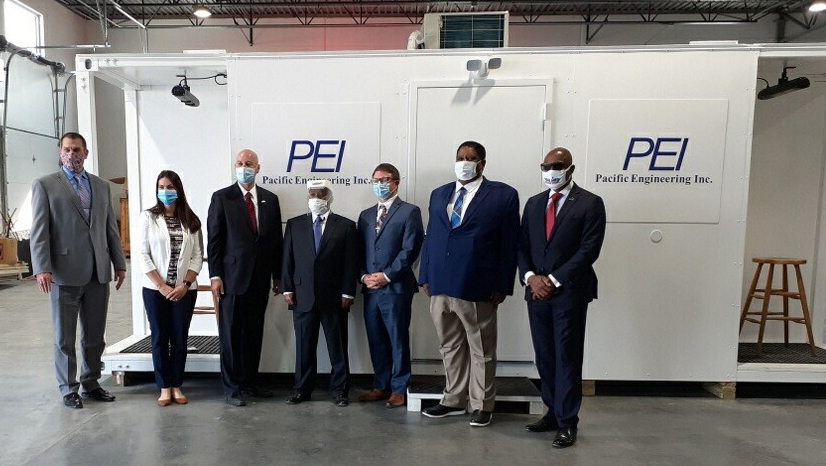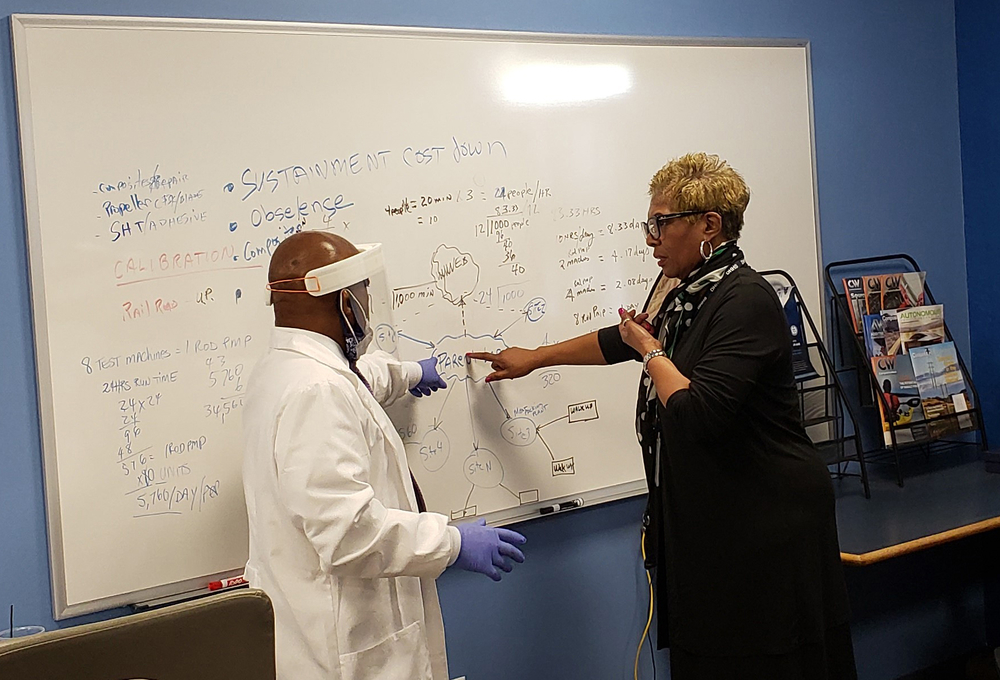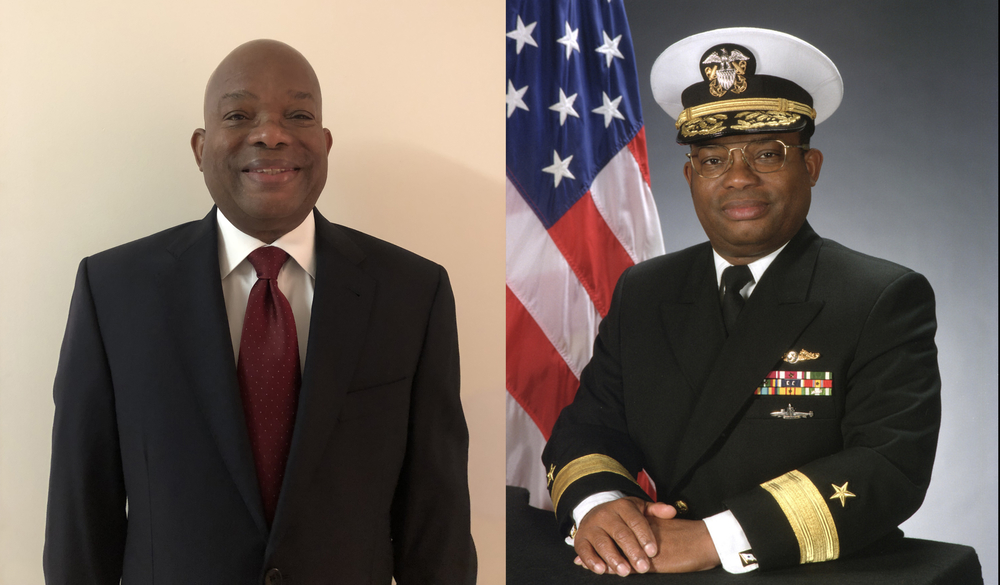Retired Rear Admiral Equips the Pandemic’s Frontline Fighters
-
-
Slice of MIT
Filed Under
Recommended

Early last March, just as the Covid-19 virus began to spread across the United States, Osie V. Combs Jr. OE ’77, SM ’77 called a meeting to see what he and his colleagues might do to combat the looming pandemic. “We asked how we could use our knowledge and capabilities to help wage war against Covid-19,” says Combs, Rear Admiral, US Navy (Retired) and president of Pacific Engineering Inc. (PEI), a small, specialized Nebraska-based defense contractor. “Because this is a war. And you can’t fight today’s war with yesterday’s weapons.”
Seven months later, PEI provided an answer, delivering the first of 10 freestanding Covid testing sites to Nebraska’s Department of Health and Human Services (DHHS). Built of lightweight yet sturdy composite materials, similar to the materials PEI uses to make military components, the company’s Rapid On Demand Portable Medical Platforms will allow the State of Nebraska to continue to offer rapid testing through the frigid winter months. They are heated, configured to protect against viral contagion, and designed to withstand winds up to 120 mph. Each walk-up unit can test up to 320 people a day, and each drive-through site can serve up to 1,200 cars per day.

This is a war. And you can’t fight today’s war with yesterday’s weapons.
“We knew rapid testing would be key,” says Combs. “We knew that testing in tents wouldn’t work in winter. And we knew there were plenty of places without hospitals or clinics that needed this service. This was the weapon we could give the people on the front lines.”

Nebraska’s DHHS deployed PEI’s first walk-up testing unit at the University of Nebraska’s Lincoln campus in mid-October, and a drive-through unit installed on the Metro Community College campus became the first permanent testing site in North Omaha. In early November PEI received an order from the Winnebago Tribal Nation, using CARES Act funding. The company is also in active negotiations with private hospitals and high-profile health care clients out of state and expects to sign multiple contracts before winter, Combs says. “The Rapid On Demand Portable Medical Platforms are designed to support the massive, expanded testing required across the country, especially in rural and underserved communities,” he emphasizes, noting that the units could eventually be used to distribute vaccinations as well.
Born in Longview, Texas, Combs received his undergraduate degree from Prairie View A&M University, majoring in electrical engineering. The Texas school was the first historically Black university to host a Naval Reserve Officer Training Corp (ROTC), and Combs was a part of it. Both Combs’s father and uncle had served in World War II; his father was an original “Montford Point Marine” who participated in combat action in the Mariana Islands, and his uncle fell during the Battle of the Bulge in Belgium. “I entered the military standing on the shoulders of those two giants,” says Combs, whose family now counts four generations of military service. “We were taught that every generation has to find a way to excel.”

Following graduation in 1971, Combs served three years in the US Navy—a term that included two tours on an aircraft carrier in combat waters off Vietnam during that conflict. One day, aboard ship, he received a phone call from an officer at the naval assignment desk. “The officer told me I was going to apply to MIT’s Course 13-A program [ocean engineer with a concentration in naval architecture and marine engineering],” says Combs. “And that after I was accepted I was to report to Cambridge in May. I clicked my heels and said, ‘Yes sir.’ From the time of acceptance to MIT and arrival, all I remember was saying over and over again: I am going to MIT. I am going to MIT.”
Combs was stunned when he arrived on the MIT campus in 1974. “I almost dropped to my knees when I understood the quality of what I was being offered there,” he recalls. Yet, along with excitement, Combs also felt a bit nervous. There were very few African Americans on campus, and fewer naval officers in his cohort. And the academic competition was tough. “I was a little behind at the beginning,” he says. “But I’m someone who worked his way through college digging ditches under the hot summer sun. By my second year I pulled even. And by my third year I started sailing. I felt there was no limit to where my mind could take me. I felt I could make a difference in the world. That’s what MIT teaches you.”
I felt there was no limit to where my mind could take me. I felt I could make a difference in the world. That’s what MIT teaches you.
After graduation from MIT, Combs rose quickly through the ranks of the US Navy, taking on increasingly challenging engineering and construction projects. He led the team that designed the Seawolf-class submarine and built and delivered the Large Scale Vehicle (LSV)—the navy’s first autonomous/unmanned submarine. He also served as chief architect for Information Technology for the 21st Century, the document that directs the navy’s strategy for IT development and application. Promoted to rear admiral in 1995—becoming one of a small group of African Americans to reach that rank—Combs, in his last assignment, oversaw all ship construction and repairs for the US Navy until retiring from the military in 1999.
Shortly after retiring, Combs opened a consulting business, working mostly with small contractors who supplied the US military. He joined PEI in 2017 and became its president the following year. He has also promoted STEM education throughout his career, including as a member of the MIT Corporation from 1997 to 2002. Combs continues to be active as a founding member of Generation Redirect, a program that has sponsored more than 50 high school students from underrepresented minorities to attend mentoring sessions at top STEM schools, including MIT. To date, every Generation Redirect graduate has majored in a STEM field at college. He also runs a “sustained mentoring” program that supports students from fifth grade through their final year in college, and in some cases through grad school and professional development.
While Combs did not envision that he would be directing the construction of mobile virus testing labs when he joined PEI three years ago, he’s not surprised to find himself and his company embarking on a new adventure. “I was trained not to be afraid to take on a challenge. Not to be afraid to try and make things better,” says Combs. “Most people look at a coin and see two sides, either heads or tails. But there’s also the edge. And it’s in those spaces along the edge where real innovation and inventions happen. That’s what I took away from MIT. The freedom to dare to work in the spaces most people don’t think to look at.”
Photographs of testing unit presentations courtesy of the Nebraska Department of Health and Human Services. Current portrait: Pacific Engineering Inc. Military portrait: US National Archives.







